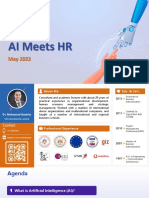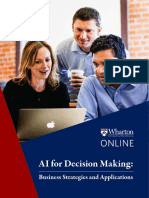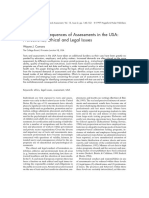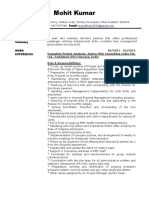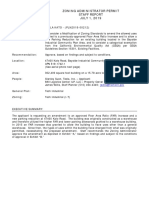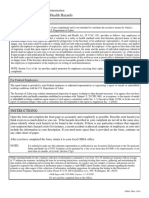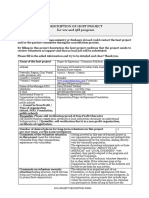A Guide to
Deep-learning AI
All AI-powered talent intelligence
platforms are not created the same—
here is what you need to know
�You might hear a lot of
claims about AI driving
talent intelligence in HR
platforms these days. Artificial
intelligence is a complicated
subject, and the applications
of AI in HR are many.
So what does
it all mean?
AI breaks down into subsets,
including machine learning
and deep learning. You
probably hear these terms
used interchangeably, but their
nuances are important for a
few key reasons.
A Guide to Deep-learning AI 1
�In addition, there are
different types of AI.
Generative AI
Generative AI is a branch of artificial
intelligence that focuses on creating new
content by learning patterns from existing
data. It uses deep learning models,
especially neural networks, to generate
outputs that resemble the data it was
trained on.
For example, Generative AI can produce
text responses that sound human-like
or create realistic images based on
written descriptions. This capability Agentic AI
opens up new possibilities in content
Agentic AI refers to artificial intelligence
creation, design, and personalized user
systems designed to autonomously plan and
experiences.
execute complex, multi-step tasks in order to
achieve specific objectives. These systems
have advanced reasoning and iterative
planning capabilities, allowing them to operate
with minimal human intervention.
In the field of talent management, for instance,
agentic AI has the potential to transform
processes by automating routine tasks,
enhancing decision-making, and providing
personalized recommendations for employee
development.
Agentic AI systems can boost efficiency and
effectiveness in dynamic environments by
continuously learning and adapting to new
information.
A Guide to Deep-learning AI 2
�Let’s break it down:
AI Machine Learning Deep learning
AI is the broadest Machine learning is a Deep learning
term for classifying subset of AI in which is a subset of machine
programs that algorithms improve learning in which
can sense, reason, act, their performance as multilayered neural
and adapt. they are exposed to networks learn from
more data over time. vast amounts of data.
A Guide to Deep-learning AI 3
�True deep-learning AI does
the manual, time-consuming
part of your job for you
Even if you loved crunching numbers in
spreadsheets, it would be impossible to
glean all the talent insights that you need
Approximately
to make the best decisions in today’s ultra-
competitive talent marketplace.
Approximately 80 to 90 percent of any
80% to 90%
organization’s data is unstructured, raw
information in many formats that isn’t of any organization’s
“clean” or ready for analysis, and it’s tough data is unstructured
to store and manage in a static database.
A Guide to Deep-learning AI 4
� It’s not about to
get any easier.
The global data
boom is well underway,
with projections of the 64.2
zettabytes we reached in
2020 to grow to more
than 180 zettabytes
by 2025.
2020
180
zettabytes
64.2
zettabytes
The digital transformation spurred by 2025
the pandemic has only accelerated this
transformation, and there’s no going back
Projection
as people do more of their daily activities—
especially their work—online.
With more data about people’s skills and
potential emerging every day through the use of
AI, how would you know that you were targeting
the right candidates, mapping out the best
career paths, or even hiring the right contingent
workers without the help of AI—and at scale
across an entire organization?
A Guide to Deep-learning AI 5
�AI-powered
talent outcomes
Talent outcomes
Understand Understand Understand
your your your
talent market competitors Autocalibrate jobs
with future skills
+ + = Hire for potential
Create personalized
upskilling journeys
That’s where deep-learning AI comes in—to sift through the unstructured datasets and surface
the most helpful insights. A true deep-learning AI talent intelligence platform uses neural networks
to identify critical information about the entire talent ecosystem, including the best candidates
for the job, learning pathways for employees to upskill, and which contingent workers should be
redeployed to new projects.
Deep-learning AI even helps you better understand where your market and industry are headed
with personalized talent insights, so you can better prepare for the future.
A true AI-driven talent intelligence platform will automate the most time-consuming and tedious
aspects of any HR or recruiter job, so the best parts of the job—connecting with and helping
people reach their true potential—are left to the talent leaders.
A Guide to Deep-learning AI 6
�AI will help
talent leaders by:
Removing or reducing menial, time-consuming tasks like
resume searching and screening, surfacing the most qualified candidates.
Automating repetitive tasks in the recruiting process to provide a more
reliable, consistent candidate experience.
Surfacing undiscovered talent for roles they might excel in and giving talent
leaders even more visibility into their workforces.
Helping talent leaders meet and exceed goals more efficiently and cementing
their status as critical contributors to an organization’s overall goals.
A Guide to Deep-learning AI 7
�Deep-learning AI, talent
intelligence for a new era
“Talent intelligence” is frequently used to describe HR platforms, but
it’s difficult to know if these platforms are truly intelligent backed by
the power of deep-learning AI.
Let’s look at what a deep-learning AI talent intelligence platform does.
An advanced AI-powered talent intelligence platform applied to your
enterprise system should reveal a comprehensive understanding of
your workforce’s capabilities, but also every person’s abilities, skills,
and potential to learn for the role.
But talent intelligence must be built on a broader, deep-learning AI
model—this is where the magic happens.
The overall breadth, scope, and quality of the global dataset captured
with a talent intelligence platform matters. Those millions—even
billions—of data points are what powers the platform. When you are
pulling from larger, more inclusive sources, this helps ensure that the
dataset is providing the most accurate recommendations about jobs,
candidates, careers, and skills at scale for any type of work anywhere
in the world.
Global datasets should also be refreshed and updated to deliver real-
time insights about every person’s potential, career trajectory, skills,
and more. AI should be continuously self-updating, helping offer even
more relevant talent information and insights backed by current data.
A Guide to Deep-learning AI 8
�Harness the power of talent intelligence
Understand
your company
Understand
your talent
Understand
your market
A true AI-powered talent intelligence platform:
Helps you better understand your company, answering questions like “What skills do I
need to achieve my business goals?”
Helps you adopt a more equitable approach, including what skills people are capable
of learning quickly, and easily determine the health of your talent pipeline across the
entire organization.
Helps you better understand your market, including what skills competitors have and
which ones you need.
A Guide to Deep-learning AI 9
�How AI can make work better for everyone
AI can help talent and business leaders find, It also has the ability to expand any
hire, retain, promote, and re-engage talent. organization’s talent pool and increase
And it also can play a huge role in reducing opportunities using a deeper understanding
unconscious bias. of skills adjacencies and learning. A platform
should expand the opportunity for choice—not
When it comes to any talent intelligence
limit it—and provide additional data for all
platform, talent leaders should ask how the AI
people to make more informed decisions.
works to target and reduce bias.
This helps create a fair, inclusive, diverse
AI can help any organization reduce bias by
workplace that welcomes people from
quickly and accurately assessing thousands
all backgrounds based on their
of resumes and identifying applicants who
potential to succeed.
may be overlooked because of human bias.
Benefits of
responsible AI:
Illuminates where great candidates
might be dropping off in the funnel,
encouraging best practices for DEI, and
inviting more diverse candidates into the
talent pipeline.
Masks personal information like names, locations,
schools that traditionally trigger unconcious bias about
individals on the basis of their gender, race, age, sexual
orientation, or disability status.
Quickly finds and surfaces the best candidates based
on skills, capabilities, and potential for the recruiter to
engage, leveling the playing field for all candidates.
Helps remove limitations and potential bias in resume
review, job description writing, and interviews.
A Guide to Deep-learning AI 10
�“I think in 10 years or sooner, AI will
be the standard of care,” says Craig
Leen, former Director of the Office of
Federal Contract Compliance Programs
(OFCCP) at the U.S. Department of
Labor. “You’ll have to use AI. You can’t
just rely on humans making decisions
that are affected by unconscious bias.”
A Guide to Deep-learning AI 11
�10 QUESTIONS
to ask a vendor about the scope of their AI:
Are the AI recommendations based on rule-based systems or real-time
1
deeper analysis of global data?
2 Can the AI support recruiting, reskilling, and retraining?
Does the AI enable the following talent functionality: skills matching,
3
career predictions, candidate experience, and bias mitigation?
How does the AI surface in the product, and does it provide explainable
4 insights on why recommendations or matches were made?
Are these recommendations actionable and made in real-time?
How their AI uses data:
Does the AI require you to provide any data to start making recommendations?
5
If so, what is needed to prepare the data?
6 What does the AI need to function correctly? How does it learn over time?
7 What’s the typical time from agreement until going live with the AI?
8 Is the AI trained on regional data, or global diversified datasets?
How AI enhances equality and diversity:
How does the AI mitigate against legacy bias in historical recruitment
9
and employee data?
10
Can your AI mask personal information to provide a fairer opportunity
to diverse candidates?
A Guide to Deep-learning AI 12
�Ready to learn more about what
deep-learning AI can do for you?
Let’s talk!
Contact us at info@eightfold.ai
Visit eightfold.ai to request a demo
Eightfold AI’s market-leading Talent Intelligence Platform™ helps
organizations retain top performers, upskill and reskill their workforce,
and recruit talent efficiently. Eightfold’s patented deep learning artificial
intelligence platform is available in more than 155 countries and 24
languages, enabling cutting-edge enterprises to transform their talent into a
competitive advantage. For more information, visit www.eightfold.ai.
A Guide to Deep-Learning AI 13














